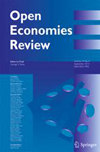期刊简介
Journal Title:Open Economies Review
The topics covered in Open Economies Review include, but are not limited to, models and applications of (1) trade flows, (2) commercial policy, (3) adjustment mechanism to external imbalances, (4) exchange rate movements, (5) alternative monetary regimes, (6) real and financial integration, (7) monetary union, (8) economic development and (9) external debt. Open Economies Review welcomes original manuscripts, both theoretical and empirical, dealing with international economic issues or national economic issues that have transnational relevance. Furthermore, Open Economies Review solicits contributions bearing on specific events on important branches of the literature. Open Economies Review is open to any and all contributions, without preferences for any particular viewpoint or school of thought. Open Economies Review encourages interdisciplinary communication and interaction among researchers in the vast area of international and transnational economics. Authors will be expected to meet the scientific standards prevailing in their respective fields, and empirical findings must be reproducible. Regardless of degree of complexity and specificity, authors are expected to write an introduction, setting forth the nature of their research and the significance of their findings, in a manner accessible to researchers in other disciplines. Officially cited as: Open Econ Rev
中文简介
《开放经济评论》涵盖的主题包括但不限于以下模型和应用:(1) 贸易流动、(2) 商业政策、(3) 外部失衡调整机制、(4) 汇率变动、(5) 替代货币制度、(6) 实体和金融一体化、(7) 货币联盟、(8) 经济发展和 (9) 外债。《开放经济评论》欢迎原创手稿,包括理论和实证,涉及具有跨国意义的国际经济问题或国家经济问题。此外,《开放经济评论》还征集与重要文献分支的特定事件相关的投稿。《开放经济评论》欢迎所有投稿,不偏向任何特定观点或思想流派。《开放经济评论》鼓励国际和跨国经济领域研究人员之间的跨学科交流和互动。作者应达到各自领域的科学标准,并且实证研究结果必须可重复。无论复杂程度和特殊性如何,作者都应撰写引言,以其他学科研究人员可以理解的方式阐述其研究的性质和研究结果的意义。官方引用为:Open Econ Rev
期刊点评
Open Economies Review由Springer Nature出版商出版,收稿方向涵盖ECONOMICS全领域,此期刊水平偏中等偏靠后,在所属细分领域中专业影响力一般,过审相对较易,如果您文章质量佳,选择此期刊,发表机率较高。平均审稿速度 ,影响因子指数1.5,该期刊近期没有被列入国际期刊预警名单,广大学者值得一试。
中科院分区(数据版本:2023年12月升级版)
| 大类学科 | 分区 | 小类学科 | 分区 | Top期刊 | 综述期刊 |
| 经济学 | 4区 | ECONOMICS 经济学 | 4区 | 否 | 否 |
名词解释:
中科院分区也叫中科院JCR分区,基础版分为13个大类学科,然后按照各类期刊影响因子分别将每个类别分为四个区,影响因子5%为1区,6%-20%为2区,21%-50%为3区,其余为4区。
中科院分区(数据版本:2022年12月升级版)
| 大类学科 | 分区 | 小类学科 | 分区 | Top期刊 | 综述期刊 |
| 经济学 | 4区 | ECONOMICS 经济学 | 4区 | 否 | 否 |
中科院分区(数据版本:2021年12月旧的升级版)
| 大类学科 | 分区 | 小类学科 | 分区 | Top期刊 | 综述期刊 |
| 经济学 | 4区 | ECONOMICS 经济学 | 4区 | 否 | 否 |
中科院分区(数据版本:2021年12月升级版)
| 大类学科 | 分区 | 小类学科 | 分区 | Top期刊 | 综述期刊 |
| 经济学 | 4区 | ECONOMICS 经济学 | 4区 | 否 | 否 |
中科院分区(数据版本:2020年12月旧的升级版)
| 大类学科 | 分区 | 小类学科 | 分区 | Top期刊 | 综述期刊 |
| 经济学 | 3区 | ECONOMICS 经济学 | 4区 | 否 | 否 |
WOS分区(数据版本:2023-2024年最新版)
| 按JIF指标学科分区 | 收录子集 | 分区 | 排名 | 百分位 |
| 学科:ECONOMICS | SSCI | Q2 | 287 / 597 |
52% |
| 按JCI指标学科分区 | 收录子集 | 分区 | 排名 | 百分位 |
| 学科:ECONOMICS | SSCI | Q3 | 368 / 600 |
38.75% |
名词解释:
WOS即Web of Science,是全球获取学术信息的重要数据库,Web of Science包括自然科学、社会科学、艺术与人文领域的信息,来自全世界近9,000种最负盛名的高影响力研究期刊及12,000多种学术会议多学科内容。给期刊分区时会按照某一个学科领域划分,根据这一学科所有按照影响因子数值降序排名,然后平均分成4等份,期刊影响因子值高的就会在高分区中,最后的划分结果分别是Q1,Q2,Q3,Q4,Q1代表质量最高。
CiteScore分区(数据版本:2024年最新版)
| CiteScore | SJR | SNIP | CiteScore排名 | ||||||||
| 2.3 | 0.478 | 0.902 |
|
名词解释:
CiteScore:衡量期刊所发表文献的平均受引用次数。
SJR:SCImago 期刊等级衡量经过加权后的期刊受引用次数。引用次数的加权值由施引期刊的学科领域和声望 (SJR) 决定。
SNIP:每篇文章中来源出版物的标准化影响将实际受引用情况对照期刊所属学科领域中预期的受引用情况进行衡量。
其他数据
| 是否OA开放访问: | h-index: | 年文章数: |
| 未开放 | -- | 40 |
| Gold OA文章占比: | 2021-2022最新影响因子(数据来源于搜索引擎): | 开源占比(OA被引用占比): |
| 34.92% | 1.5 | |
| 研究类文章占比:文章 ÷(文章 + 综述) | 期刊收录: | 中科院《国际期刊预警名单(试行)》名单: |
| 97.50% | SCIE、SSCI | 否 |
历年IF值(影响因子):
历年引文指标和发文量:
相关期刊
| 同小类学科的其他优质期刊 | 影响因子 | 中科院分区 |
| Socio-economic Planning Sciences | 6.2 | 2区 |
| Environmental Innovation And Societal Transitions | 5.7 | 2区 |
| Econometrica | 6.6 | 1区 |
| Finance And Stochastics | 1.1 | 2区 |
| Agricultural Economics | 4.5 | 3区 |
| Agribusiness | 2.1 | 3区 |
| German Journal Of Agricultural Economics | 0.7 | 4区 |
| Mathematical Finance | 1.6 | 3区 |
| Journal Of Econometrics | 9.9 | 3区 |
| International Review Of Financial Analysis | 7.5 | 1区 |
更多问题
免责声明
本站仅销售经国家新闻出版署批准的合法期刊,不是任何杂志官网,不涉及出版事务。本站仅提供有限咨询服务,需要用户自己向出版商投稿且没有绿色通道,是否录用一切以出版商通知为准。提及的第三方名称或商标,其知识产权均属于相应的出版商或期刊,本站与上述机构无从属关系,所有引用均出于解释服务内容的考量,符合商标法规范。本页信息均由法务团队进行把关,若期刊信息有任何问题,请联系在线客服,我们会认真核实处理。 若用户需要出版服务,请联系出版商。
